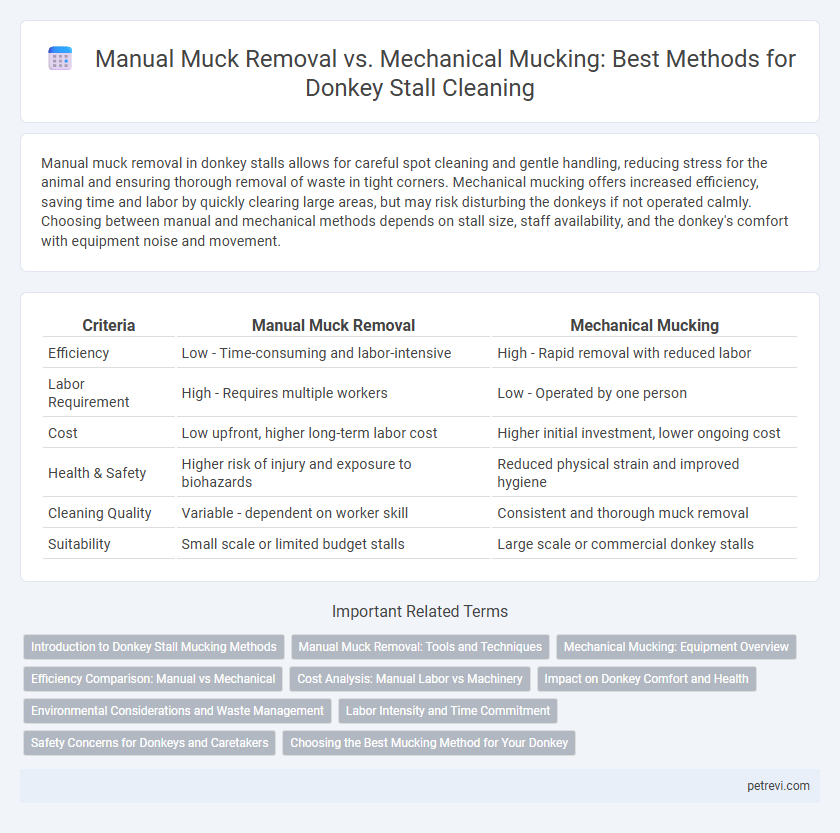Manual muck removal in donkey stalls allows for careful spot cleaning and gentle handling, reducing stress for the animal and ensuring thorough removal of waste in tight corners. Mechanical mucking offers increased efficiency, saving time and labor by quickly clearing large areas, but may risk disturbing the donkeys if not operated calmly. Choosing between manual and mechanical methods depends on stall size, staff availability, and the donkey's comfort with equipment noise and movement.
Table of Comparison
| Criteria | Manual Muck Removal | Mechanical Mucking |
|---|---|---|
| Efficiency | Low - Time-consuming and labor-intensive | High - Rapid removal with reduced labor |
| Labor Requirement | High - Requires multiple workers | Low - Operated by one person |
| Cost | Low upfront, higher long-term labor cost | Higher initial investment, lower ongoing cost |
| Health & Safety | Higher risk of injury and exposure to biohazards | Reduced physical strain and improved hygiene |
| Cleaning Quality | Variable - dependent on worker skill | Consistent and thorough muck removal |
| Suitability | Small scale or limited budget stalls | Large scale or commercial donkey stalls |
Introduction to Donkey Stall Mucking Methods
Manual muck removal in donkey stall cleaning involves using hand tools like pitchforks and shovels to remove waste, allowing for careful attention to detail but requiring significant physical effort. Mechanical mucking employs equipment such as manure spreaders or automated scrapers, increasing efficiency and speed while reducing labor intensity. Choosing between these methods depends on stall size, budget, and desired cleaning frequency for optimal donkey hygiene and stall maintenance.
Manual Muck Removal: Tools and Techniques
Manual muck removal in donkey stall cleaning relies on essential tools such as pitchforks, shovels, and wheelbarrows to effectively remove manure and soiled bedding. Techniques emphasize thorough scraping and separation of solid waste to maintain hygiene and prevent odor buildup. Consistent manual mucking enhances stall health by minimizing ammonia levels and promoting better air quality for donkeys.
Mechanical Mucking: Equipment Overview
Mechanical mucking for donkey stall cleaning utilizes advanced equipment such as automatic scrapers, conveyor belts, and specialized mucking machines designed for efficient manure removal. These devices significantly reduce labor intensity and improve hygiene by rapidly clearing waste materials and minimizing ammonia buildup. Equipment like front loaders and robotic muck cleaners enhance operational speed, ensuring a healthier environment for donkeys while maintaining stall cleanliness.
Efficiency Comparison: Manual vs Mechanical
Mechanical mucking in donkey stall cleaning significantly enhances efficiency by reducing labor time from hours to minutes compared to manual removal. The use of mechanized tools like skid steers or mucking machines accelerates waste extraction, ensures thorough cleaning, and minimizes physical strain on workers. In contrast, manual mucking, while cost-effective for smaller stalls, is labor-intensive and less consistent in maintaining optimal stall hygiene.
Cost Analysis: Manual Labor vs Machinery
Manual muck removal for donkey stall cleaning involves higher ongoing labor costs due to the intensive physical effort and time required, whereas mechanical mucking demands a significant initial investment in equipment but reduces labor expenses over time. The cost-effectiveness of mechanical systems increases with the scale of operation and frequency of cleaning, making it more advantageous for larger stables with multiple donkeys. Evaluating long-term savings and productivity improvements is essential when comparing manual labor costs against machinery expenses in stable maintenance.
Impact on Donkey Comfort and Health
Manual muck removal in donkey stalls allows for gentle handling, reducing stress and minimizing the risk of injury, which directly supports donkey comfort and health. Mechanical mucking speeds up the cleaning process but can cause noise and vibrations that may stress donkeys, potentially leading to respiratory issues or behavioral problems. Optimizing stall cleanliness while maintaining a calm environment is crucial for preventing hoof infections and promoting overall well-being in donkeys.
Environmental Considerations and Waste Management
Manual muck removal in donkey stall cleaning allows for selective waste sorting, promoting composting and reducing environmental impact through organic recycling. Mechanical mucking speeds up waste removal but can lead to increased runoff and potential contamination if not managed with proper filtration systems. Implementing effective waste management protocols, such as nutrient-rich manure collection and biofiltration, is essential to minimize pollution and support sustainable equine care.
Labor Intensity and Time Commitment
Manual muck removal in donkey stall cleaning demands high labor intensity, requiring prolonged physical effort to scoop and dispose of waste, often leading to fatigue. Mechanical mucking significantly reduces labor by utilizing equipment such as mucking machines or automated scrapers, speeding up the process and decreasing time commitment. This mechanized approach improves efficiency, allowing for more frequent and thorough cleaning cycles with less human strain.
Safety Concerns for Donkeys and Caretakers
Manual muck removal in donkey stall cleaning presents significant safety risks, including exposure to harmful pathogens and physical strain for caretakers handling heavy loads. Mechanical mucking reduces these risks by minimizing direct contact with waste, decreasing the likelihood of zoonotic infections and musculoskeletal injuries. Proper training and equipment maintenance are essential to ensure both donkey welfare and caretaker safety during mechanical mucking operations.
Choosing the Best Mucking Method for Your Donkey
Manual muck removal allows for thorough, hands-on cleaning of donkey stalls, offering precise attention to waste and bedding condition. Mechanical mucking speeds up the process and reduces labor intensity, ideal for larger operations with multiple donkeys. Evaluating stall size, budget, and donkey comfort helps determine whether manual or mechanical mucking best suits your donkey's hygiene needs.
Manual Muck Removal vs Mechanical Mucking for Donkey Stall Cleaning Infographic

 petrevi.com
petrevi.com